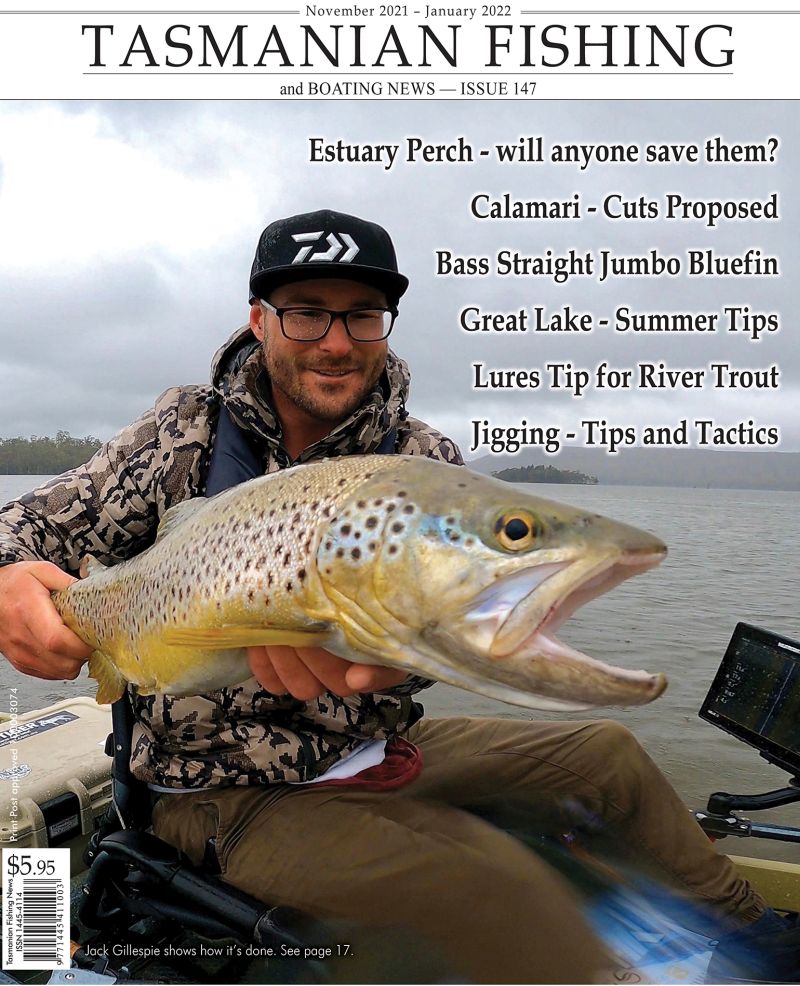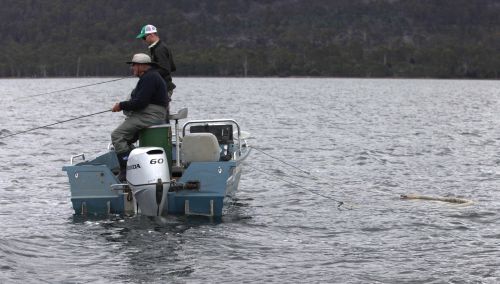Mid Sea-Run Season Report
Sea-run trout fishing this year got off to a cracking start in most areas, with the majority of anglers employing nearly every trout fishing technique to secure fish in local estuaries statewide.
Even those anglers fishing the "off-season" lower down in our estuaries for sea-trout commented on the number of fish moving in early August.
Those opening two weeks were fairly mild and settled with little or no flooding statewide and resultant good fishing. Mid August was a different story and a low pressure cell and a S.W Antarctic blast of snow, sleet and rain ensured major flooding statewide and a "coup de grace" for the fantastic sea-run fishing we had just experienced.
The second weekend in August (one week before the onset of the above mentioned bad weather) saw me fishing a high tide above Bridgewater on the Derwent River during a drizzly SW front. I started fishing at around 4.30pm and within 15 minutes had two sea-run browns of about 2LB laying on the bank. Continuing to fish I hooked and lost two other fish in the following 11/2 hours of light.
An interesting point worth noting here is that all trout were hooked by casting parallel to the shore against the rushes. This is a common ambush technique used by sea-trout both high and low in our states estuary systems.
Natural flooding in the following 2 - 3 weeks saw only the keenest of trout angles braving the cold and confidence breaking murky river waters. Surprisingly, some anglers did well with reports in most reaches of fish being taken.
It must be remembered that all of our major river systems during winter and spring are renowned for big flushes of fresh snow and rainwater. As seen 6 weeks ago the quality of angling usually declines for the duration of the bad weather and murky waters. The good news is it only takes about 1 week (without continued rain or snow) for the stained water to clear. I have found fishing to be exceptional just as estuary systems are beginning to clear, as trout are normally quiet hungry having been inhibited nearly as much as the angler, and the still murky water masks your lure and makes it hard for trout to inspect your offering as much as they normally would. Anglers fishing the clearing period are very much targeting sea-trout in a 'snatch and grab" frame of mind. In other words they would rather rush in and grab a lure or fly than miss out in the less than ideal feeding conditions.
September 17th saw me out once again in clearing water conditions, this time lower down in the Derwent towards Geilston Bay, in the belief the main run / body of sea-run fish may have dropped back rather than moved up further against the flooding water.
The afternoon was not ideal with 30 - 40 knot NW winds, but we had an incoming and almost full tide. This type of bad weather may not be ideal for the angler but sea-run trout tend to feed more actively due to increased wave action, light reduction and prey redistribution and dislodgment. Deteriorating weather such as this (breeze, drizzle, cloud etc) usually heralds the onset of a dropping, or more importantly, changing barometer which can work in the anglers favour. Weather such as this normally precedes a westerly frontal system. Feeding inhibitions that trout may have are largely forgotten and a short pre-bad weather frenzy is sometimes experienced.
The five of us stood casting into the nearly gale forced winds at times, only casting minnow style lures 10 - 15m behind the oncoming breakers. In 21/2 hours, we still managed to land 2 fish; 1 sea-runner and 1 resident of 3.5LB. Robin Banks managed to land his first ever trout in what can only be described as atrocious conditions. In the last two weeks before print, sea-run activity has picked up dramatically and is still shaping up for an explosive October and November fishing period.
Following is some sea-run basics and helpful hints to help get you through the next two months.
In October - November 1998, "Seeking Sea-Run Trout" I noted that sea-runners are brown trout (salmo trutta) that have, as juvenile fingerlings, made a decision to move away from freshwater and live in saltwater. Resident trout are those fish which have moved into saltwater but have chosen not to leave the confines of estuary and unlike sea-trout do not turn silver or lose any of their usual spots. True sea-runners on the other hand are those fish which choose to leave an estuary, feeding heavily on the varied and abundant food items our nutrient-enriched oceans have to offer. Trout choosing to lead a sea life grow faster, stronger and bigger than resident trout. Sea trout after some time at sea become silver and chrome-like in appearance. Tremendously high levels of fitness and stamina are quickly built up as well.
Sea-runners become vulnerable to anglers at two times of the year which are at times of spawning and at the moment during the white-bait runs. As I further noted, all trout are waiting to gorge themselves on the first of two major baitfish migrations. Sea-runners feed on these baitfish so ferociously that they too become part of the run and once again head up the rivers. For 2 - 3 months of the year, namely August to November, whitebait form the main part of a sea-runners diet. Whitebait refers to approximately 5 - 6 species of native baitfish. The first run of whitebait builds steadily throughout August and as we saw, peaks in early September. By now whitebait can be seen congregating at he mouths of small creeks, storm-water drains and natural culverts. Look at these areas when next on the river. Such schools can be bailed up into a tight ball and just hit time and time again by hungry sea-runners. Intense feeding only increases further when a second run of whitebait occurs shortly in October and November. Although slow this season, by the time the second run begins all anglers whether they spin, fly or bait fish should be experiencing almost magical fishing conditions.
Spinning for sea-run trout would have to be the most commonly practised fishing method. Due to the fact that spinning is so easy and regardless of fishing experience, nearly everybody can do it. Spinning is basically the art of casting and retrieving an artificial lure that looks and acts like a baitfish which sea-runners chase. Choosing a good quality monofilament spinning line is vitally important. Sea-runners will be targeted in and around sharp mussels, oysters and rocks. All of these will test the breaking strain and knot strength of any monofilament. Choose a lure with plenty of action to imitate a wounded baitfish. Sea-runners like attacking any lure with a splash of silver, bronze or white in its colour scheme. So far this year trout are feeding deep on crabs and have been taking silver and green coloured lures quite readily. Natural colours work well but do not be afraid of trying more vibrant colours in order to elicit a response. A fly dropper can be used spinning or trolling, and is a wet fly that is placed in front of the lure. In this way, when the lure is spun or trolled, it looks to be chasing a small baitfish.
At the moment fly fisherman are well catered for with the promise of lively sea-run fishing during October and November. The fly fishing style is strictly wet. This year fly fisherman will have started fishing blind but will soon begin to sight fish when sea-runners start chasing whitebait in estuary shallows. Fish will be stalked as they charge and swirl at baitfish. Flies should be chosen on the basis of size, shape and colour and should bear a close resemblance to whitebait.
Baitfishing is the deadliest way of catching a sea-runner. Bottom baiting is another popular method with above baits. For best results in daylight try early morning or late afternoon. These are placed on a size 4 - 6 hook and cast out on a simple running rig and a trout, after taking the bait, is allowed to run, stop and then struck.
Serious spin and fly fishermen target sea-runners early in the morning and late in the afternoon knowing that sea-runners, like all trout, loathe bright conditions. Occasionally the angler may be faced with an overcast, windy and drizzly day ,sea-runners tend to be highly active in such conditions and are only too eager to snap at a lure or fly. Incoming tides give trout an ideal opportunity to give chase and attack baitfish relentlessly. Sea trout lie in waiting at the edges of the drop-offs and viciously attack whitebait as they go. Bait fishermen prefer the incoming tide, but fish it from its low point to its highest point.
Sea-runners can be caught from nearly any shore in an estuary system. Usually anglers, at the start of the season, start fishing low in rivers and slowly fish their way upriver until they find the main run of sea trout. From then on each trip is planned around where the fish are in the river rather than where they are not. At the moment, after 8 weeks of fishing, anglers should be targeting the mid reaches of our estuaries. Good fishing spots are found in these mid reaches , prominent points, deep channels or shorelines that have good weed beds within casting distance. Fishing an area with a tidal flow or current is always a good choice, as sea-runners like feeding in such areas. Sea runners are by no means easy to catch.
These trout would have what would seem to be very mystical and secretive behaviour patterns that seem only to excite the most dedicated of anglers. In order to catch a sea-runner new anglers must be prepared to put in the hours at the river and be ale to take the good days with the bad. A sea-run angler must, above all, be patient and prepared to experience the odd blank outing, snagged tackle, lost lures and a little frustration. The rewards are there for the persistent angler.
Good luck in October and November.
Andrew Large



